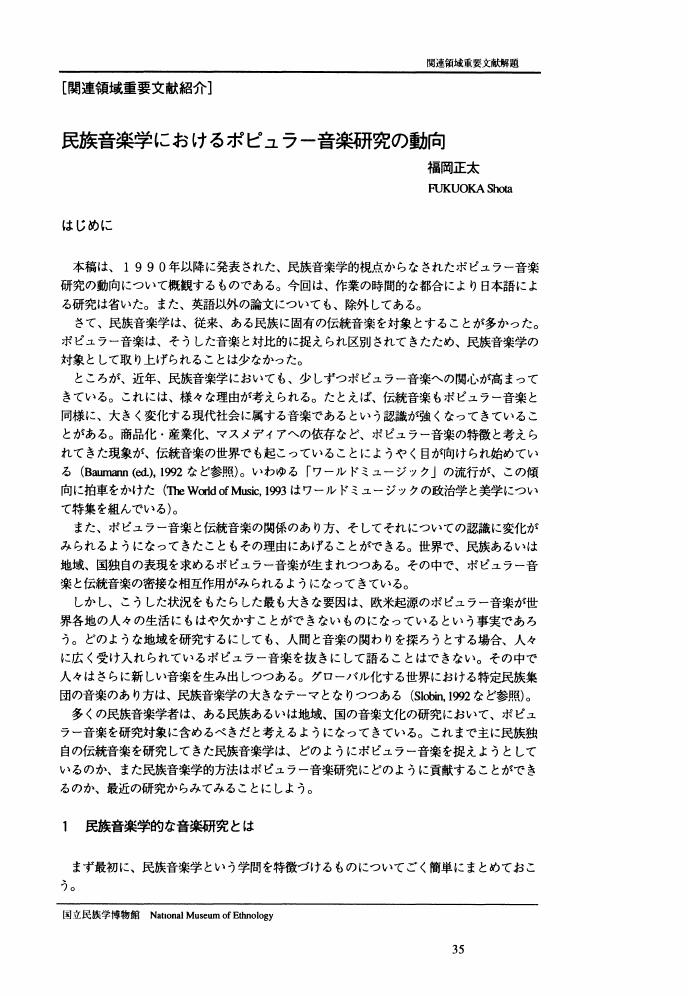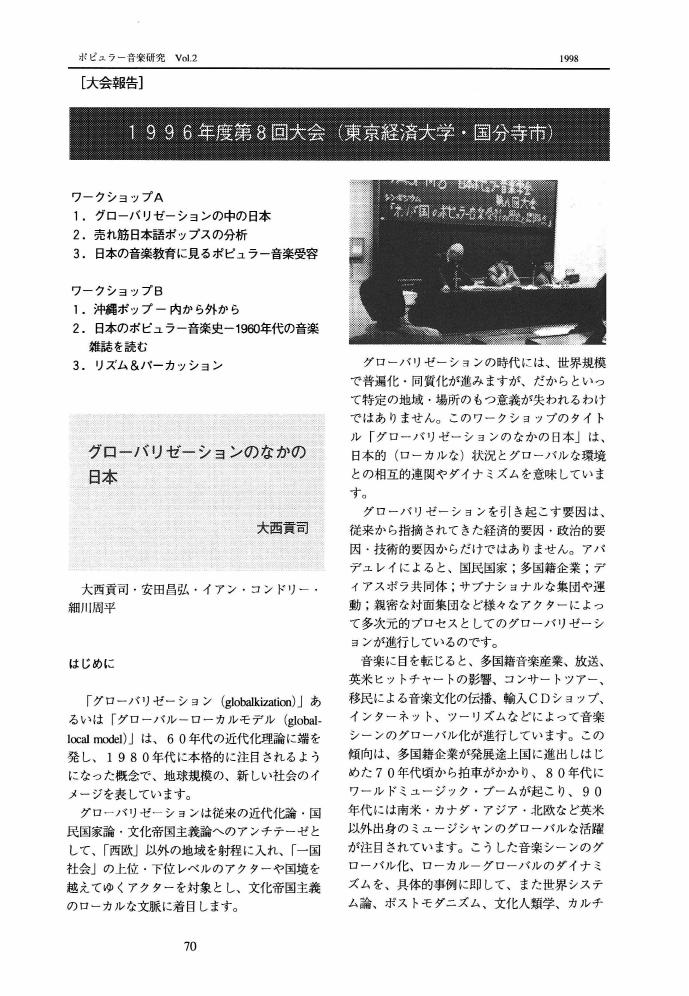1 0 0 0 'Yesterday Once More'の解釈について
- 著者
- 土屋 唯之
- 出版者
- The Japanese Association for the Study of Popular Music
- 雑誌
- ポピュラー音楽研究 (ISSN:13439251)
- 巻号頁・発行日
- vol.4, pp.20-30, 2000
What does 'Yesterday Once More' mean? In the original version by John Bettis, we can see it as 'Yesterday, Once More, ' but now the title 'Yesterday Once More' is known well. Therefore, we show that we can interprete this as an adverbial phrase, a noun phrase (Yesterday as a subject and as an object), and Yesterday as a vocative. As a result, 'Yesterday Once More' may be better than 'Yesterday, Once More' because the former makes us imply various kinds of interpretations.<br>We also show that sha-la-la-la, wo-o-wo-o and shing-a-ling-a-ling are the introduction of some hit songs before the publication of 'Yesterday Once More' (1973).<br>As for "It's yesterday once more" we can find twice, we cannot understand its true meaning until we interprete them as "It's yesterday that I lost my love once more" and "It's the song 'Yesterday Once More.'"
- 著者
- 森川 卓夫
- 出版者
- The Japanese Association for the Study of Popular Music
- 雑誌
- ポピュラー音楽研究 (ISSN:13439251)
- 巻号頁・発行日
- vol.5, pp.48-53, 2001 (Released:2009-10-29)
- 参考文献数
- 9
1 0 0 0 カルチュラル・スタディーズにおけるポピュラー音楽
- 著者
- 粟谷 佳司
- 出版者
- 日本ポピュラー音楽学会
- 雑誌
- ポピュラー音楽研究 (ISSN:13439251)
- 巻号頁・発行日
- no.6, pp.63-72, 2002
1 0 0 0 OA [書評] 毛利嘉孝著『ポピュラー音楽と資本主義』
- 著者
- 木本 玲一
- 出版者
- 日本ポピュラー音楽学会
- 雑誌
- ポピュラー音楽研究 (ISSN:13439251)
- 巻号頁・発行日
- vol.11, pp.23-25, 2007 (Released:2009-10-29)
1 0 0 0 音楽家による援助活動:アフリカの食糧危機を事例として
- 著者
- 平泉 金弥
- 出版者
- The Japanese Association for the Study of Popular Music
- 雑誌
- ポピュラー音楽研究 (ISSN:13439251)
- 巻号頁・発行日
- vol.6, pp.3-16, 2002
本稿では、バンドエイドからライブエイドまでの音楽家による援助活動が分析され、人間の感性に訴える特性を持つこれらの活動ないし音楽が、異文化理解を促進させ、世界構造の対話を促進させるための一つの方法として機能することが考察される。それによって、自己と他者とが〈断絶された関係〉から〈連続する関係〉へと転換する可能性を指摘し、この転換を促進するために、音楽家が今後世界的な役割を担うであろうと結論づけられる。
1 0 0 0 OA 東京キューバン・ボーイズと「日本」
- 著者
- 西村 秀人
- 出版者
- 日本ポピュラー音楽学会
- 雑誌
- ポピュラー音楽研究 (ISSN:13439251)
- 巻号頁・発行日
- vol.1, pp.53-59, 1997-11-30 (Released:2009-10-29)
- 参考文献数
- 11
1 0 0 0 OA 民族音楽学におけるポピュラー音楽研究の動向
- 著者
- 福岡 正太
- 出版者
- 日本ポピュラー音楽学会
- 雑誌
- ポピュラー音楽研究 (ISSN:13439251)
- 巻号頁・発行日
- vol.1, pp.35-43, 1997-11-30 (Released:2009-10-29)
- 参考文献数
- 53
- 被引用文献数
- 1
1 0 0 0 ハワイの「日本の歌」とナイト・クラブ
- 著者
- 中原 ゆかり
- 出版者
- 日本ポピュラー音楽学会
- 雑誌
- ポピュラー音楽研究 (ISSN:13439251)
- 巻号頁・発行日
- no.8, pp.35-44, 2004
本稿の目的は、1950年代はじめから1970年代後半までのハワイで日本のポピュラー音楽の演奏を行っていたナイト・クラブについて報告することにある。これらのナイト・クラブは、1950年代はじめから1960年前後までが数も多く、生演奏の他に日本舞踊やストリップ・ショー等もあり、ドアの外で客たちが並ぶほどであった。その後1960年代から1970年代へと時代が下るにつれて数も減り、演奏する曲目もアメリカのポピュラー音楽の占める割合が増えて、1970年代後半には姿を消した。<br>ナイト・クラブの状況から、全く日本のポピュラー音楽のみを好んでいたのはごく一部の二世までであり、三世以降の日本のポピュラー音楽の愛好者はアメリカのポピュラーも愛好していると推察できる。
1 0 0 0 日本ブームと台湾芸能界
- 著者
- 石谷 崇史
- 出版者
- 日本ポピュラー音楽学会
- 雑誌
- ポピュラー音楽研究 (ISSN:13439251)
- 巻号頁・発行日
- no.4, pp.58-61, 2000
1 0 0 0 JASPM18大会報告
- 出版者
- 日本ポピュラー音楽学会
- 雑誌
- ポピュラー音楽研究 (ISSN:13439251)
- 巻号頁・発行日
- no.11, pp.42-54, 2007
1 0 0 0 OA 戦後ハワイで活躍した二世楽団
- 著者
- 中原 ゆかり
- 出版者
- The Japanese Association for the Study of Popular Music
- 雑誌
- ポピュラー音楽研究 (ISSN:13439251)
- 巻号頁・発行日
- vol.6, pp.39-50, 2002 (Released:2009-10-29)
- 参考文献数
- 16
This essay concerns the activity of the Nisei amateur orchestras in Hawai'i after the Pacific War.In the postwar period, there were more than 40 Nisei orchestras performing Japanese popular songs at events and parties held by and for Americans of Japanese ancestry in Hawaii. Some of the orchestras also put on stage shows and produced many records. Of the few pieces composed by Nisei musicians, “Wakare no Iso Chidori, ” composed by Francis Zanami, became a big hit in Hawaii. A few years after it's release in Hawaii, a famous Japanese singer, OMI Toshiro, also recorded this song and his version became quite popular in Japan. Over the same period, several Nisei singers made their debuts in Japan as well.The Nisei Orchestras flourished only for four or five years after the war. In that short period, they used music as a tool to express their confidence and pride as Americans of Japanese ancestry, as well as to reestablish ties with the land of their parents.
1 0 0 0 OA ローカル・ジュークボックス:音楽の地方市場で形成される「生産の文化」について
- 著者
- 梅田 茂樹
- 出版者
- The Japanese Association for the Study of Popular Music
- 雑誌
- ポピュラー音楽研究 (ISSN:13439251)
- 巻号頁・発行日
- vol.5, pp.2-17, 2001 (Released:2009-10-29)
- 参考文献数
- 23
This article discusses the cultural process of a local record retailer in a local music market through giving a description of its occupational activities. I take Yamachiku, which is the largest retail chain in Kanazawa, as an example of how a record retailer plays an important role in the production and consumption of music. In order to illustrate the process, I make use of ‘the culture of production’ perspective highlighting the corporate personnels as the cultural intermediaries. Then I focus on the local networks which allow Yamachiku to work successfully and want to show that its unique practices are in large part based on the location of it. In this article I seek to contribute to our overall understanding of Japanese music industry through examining the cultural practices of a local corporate organization.
1 0 0 0 OA JASPM18大会報告
- 出版者
- 日本ポピュラー音楽学会
- 雑誌
- ポピュラー音楽研究 (ISSN:13439251)
- 巻号頁・発行日
- vol.11, pp.42-54, 2007 (Released:2009-10-29)
1 0 0 0 路上演奏者の公共感覚:心斎橋の弾き語りシンガーを事例として
- 著者
- 木島 由晶
- 出版者
- 日本ポピュラー音楽学会
- 雑誌
- ポピュラー音楽研究 (ISSN:13439251)
- 巻号頁・発行日
- vol.10, pp.16-39, 2006
- 被引用文献数
- 1
近年の路上演奏は、都市部における青年文化の文脈で捉えられやすい。本稿はこの観点を継承し、大阪有数の都市である心斎橋周辺をモデル・ケースとして、路上文化の今日的な様相を示す。分析の前半では、169名分のインタビュー・データを整理して演者の意識の傾向を把握する。これをふまえて後半では、フィールド・リサーチの知見を導入して路上文化の特色を位置づける。以上の分析から得られた知見は、つぎの3点である。(1)路上文化が定着した要因には、通行人に対する意識の低下よりも、路上に対する安心感の高まりが大きい。(2)路上で自由に演奏してもよいという感覚は、今日では演者当人をこえて、演者をとりまく警察や自治体の側に波及している。(3)こうした状況の変化は、演者の二極化傾向を促進させる。一方は、通行人を意識しないで気ままに演奏を楽しむスタイルであり、他方は、通行人を強く意識してレコード・デビューを目指すスタイルである。
1 0 0 0 OA 『Pupular Music in Theory』再訪
- 著者
- 安田 昌弘
- 出版者
- The Japanese Association for the Study of Popular Music
- 雑誌
- ポピュラー音楽研究 (ISSN:13439251)
- 巻号頁・発行日
- vol.6, pp.51-61, 2002 (Released:2009-10-29)
- 参考文献数
- 26
雲の切れ目から日のさす晩秋のロンドンでキース・ニーガス氏と話す機会に恵まれた。ニーガス氏の『Popular Music in Theory』が出版されたのは一九九六年。絶好のポピュラー音楽研究入門書として日本でも多く読まれているようだ。彼はその後もオープン大学の二冊[Negus 1997, du Gay et al. 1997]や、『Music Genres and Corporate Cultures』[1999]、そして『Popular Music Studies』[2002]と精力的な活動を続けている。この対談は『Popular Music in Theory』以降のポピュラー音楽研究の理論的布陣の移り変わりや、新しい調査成果の進展を俯瞰することを意図してもうけられた。限られた誌面ゆえその全てを掲載することはできないが、特に「生産の文化」、「アイデンティティ」、「グローバライゼーション」のキーワードを中心にお届けする。
1 0 0 0 OA JASPM8・9大会報告
- 出版者
- 日本ポピュラー音楽学会
- 雑誌
- ポピュラー音楽研究 (ISSN:13439251)
- 巻号頁・発行日
- vol.2, pp.70-92, 1998-11-30 (Released:2009-10-29)





